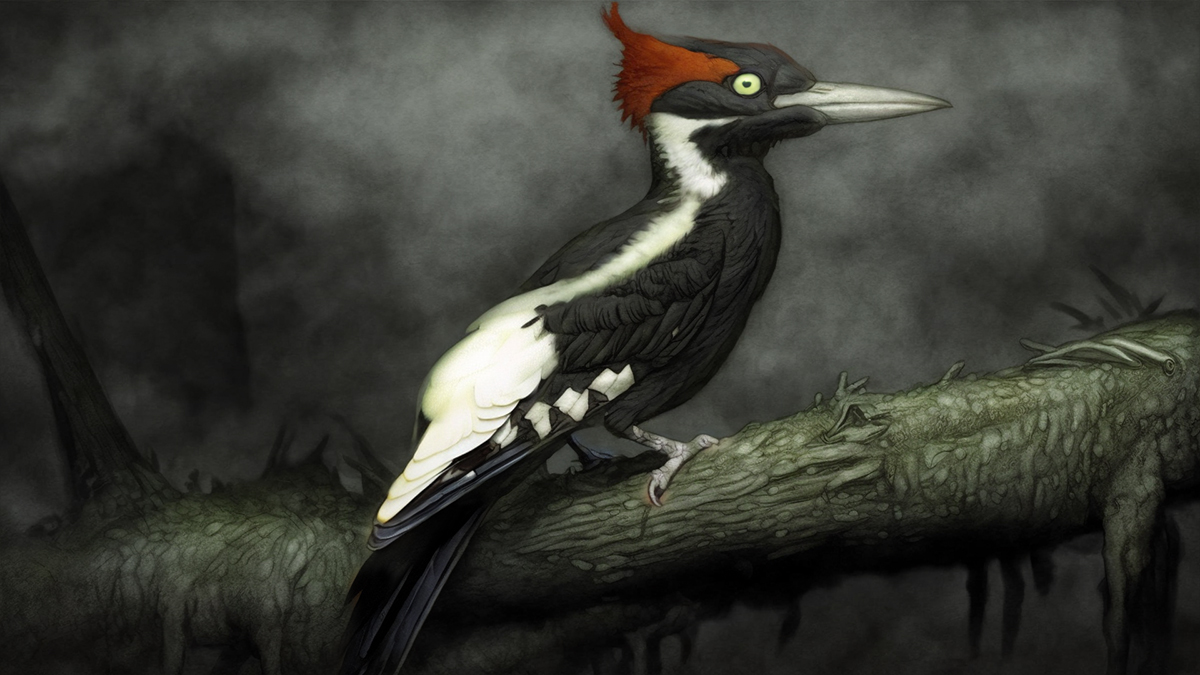The Ivory-billed woodpecker, Campephilus principalis, is officially classified as critically endangered or possibly extinct and generates a great deal of research and debate as to whether or not it still exists.
Description
The Ivory-billed woodpecker was the largest woodpecker to reside in the USA and, indeed, was one of the world’s largest of the species.
The bird’s territory once spanned most of the southeast USA and as far north as southern Illinois. Preferring large tracts of hardwood forests with easy access to water, their diet consisted of beetle larvae, insects found in dead or dying trees, and some seeds and fruits.
They made their nests in dead trees, and both parents looked after the chicks. It is believed that mates are paired for life.
Numbers began to decline quickly in the 1800s, and the continued destruction of their natural habitats led to severe doubts that any of these birds had managed to survive.
In fact, in the last 100 years, the species has only been linked to swamp forests.
This being the case, much of what is known about the Ivory-billed Woodpecker has been derived from old reports and illustrations.
These birds were around 20 inches long and had a 30-inch wingspan. Distinguishing marks included white markings on their neck and back, white coloring on the trailing edge of their upper and under wings, pale yellow eyes, and, of course, ivory-colored bills. A white triangle could be seen on their lower back when their wings were folded. Males were identified by a bright red crest.
Uniquely, they made a double-knock sound when pecking against trees – a crucial aid in confirming any sightings of these birds.
In 2021, the U.S. Fish and Wildlife Service nailed its colors to the mast in the debate on the Ivory-billed Woodpecker, officially removing the bird from the endangered species list and declaring it extinct. The organization said it made its decision using “the best scientific and commercial data available.”
Ivory-billed Woodpecker hunter, Matt Courtman, has continued the fight to get the bird back on the endangered list. Courtman’s fear is that the extinct declaration will lead to further destruction of the woodpecker’s habitat, thereby leading, ironically, to its actual extinction.
Sightings and Tales
In 2005, a video surfaced which seemed to show a live Ivory-billed Woodpecker. The footage was taken in a swamp forest in Arkansas.
Some experts support the footage, but others suggest that the bird in the footage is actually a pileated woodpecker – a smaller woodpecker that is very similar to the Ivory-billed Woodpecker.
Another recent sighting came in 2004 when a group from the Cornell Lab of Ornithology searched a swamp in Arkansas. The evidence, however, proved inconclusive.
There have been suggestions that the 2004 report was orchestrated by the Nature Conservancy. This organization stood to benefit from any sightings and may have been granted millions of dollars and hundreds of thousands of acres of land in Arkansas. The Nature Conservancy neither confirms nor denies receiving any funding.
Michael Collins, who works at the Stennis Space Center in Mississippi, has been researching the ivory-billed woodpecker for more than 10 years.
Between 2005 and 2013, Michael spent 1500 hours looking for the bird, saying he had had 10 sightings in that time.
His video and audio footage is compelling, presenting findings consistent with historical evidence and reports.
While in the Green Swamp area, Polk Co., Florida, in 1967, ornithologist David S. Lee, curator emeritus of birds at the North Carolina State Museum of Natural Sciences, purportedly saw an ivory-billed woodpecker fly across a road 25 yards in front of him.
David, who was then a student, returned to the scene with his professor. They found that large pieces of bark had been removed from trees, which is typical of ivory-billed woodpecker feeding activity.
Nearby, and at around the same time, ivory-billed woodpecker hunters H. Norton Agey and George M. Heinzmann said they saw or heard one of the birds on a total of 11 occasions between 1967 and 1969. Interestingly, a feather found near a tree cavity was discovered to have belonged to an ivory-billed woodpecker.
John Dennis claimed to have recorded one of the birds in 1968 while in Neches River Swamp, Texas. The recording’s authenticity was questioned at the time. Following recent analysis, acoustics experts at the Cornell Lab of Ornithology believe the recording is genuine.
The government’s last confirmed sighting of the Ivory-billed Woodpecker was in 1944, although there have been regular reports of alleged sightings ever since.
| Other Name/s | Lord God Bird |
| Location | Cuba, United States, |
| Type | Extinct, Bird |
| Habitat | Forest |
Links
References
ivorybill.org, “The Ivory Billed Woodpecker,” accessed September 11, 2017,
nationalgeographic.com, “Ivory-Billed Woodpecker,” accessed September 11, 2017,
foxnews.com, “Extinct or not? New study claims ‘extinct’ ivory-billed woodpecker is still alive,” accessed September 11, 2017,
birdwatchingdaily.com, “Historic ranges and 22 reported sightings of Ivory-billed Woodpeckers since 1944,” accessed September 11, 2017,
https://www.washingtonpost.com/climate-environment/2021/09/29/endangered-species-ivory-billed-woodpecker/, “Ivory-billed woodpecker officially declared extinct, along with 22 other species,” accessed March 14, 2023,
https://www.cnn.com/interactive/2022/us/ivory-billed-woodpecker-extinct-courtman-climate-ctpr/, “Is the ivory-billed woodpecker extinct?” accessed March 14, 2023.
